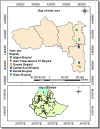Frequency of MTB and rifampicin resistance MTB using Xpert-MTB/RIF assay among adult presumptive tuberculosis patients in Tigray, Northern Ethiopia: A cross sectional study
- PMID: 33147218
- PMCID: PMC7641410
- DOI: 10.1371/journal.pone.0240361
Frequency of MTB and rifampicin resistance MTB using Xpert-MTB/RIF assay among adult presumptive tuberculosis patients in Tigray, Northern Ethiopia: A cross sectional study
Abstract
Background: Multidrug-resistant tuberculosis (MDR-TB) continues to be a global health problem. Data on rifampicin resistance MTB using Xpert- MTB/RIF assay in Ethiopia, particularly in the study area is limited. The aim of this study was to determine the frequency of MTB and rifampicin resistant-MTB among presumptive tuberculosis patients in Tigray, Northern Ethiopia.
Methods: A multicenter retrospective study was conducted among presumptive TB patients from five governmental hospitals and one comprehensive specialized teaching hospital in Tigray regional state. Records of sputum sample results of presumptive MTB patients with Xpert-MTB/RIF assay from January 2016 to December 2019 were investigated. Data extraction tool was used to collect data from registration books and analyzed using SPSS ver.21 statistical software. Statistical significance was set at p-value ≤ 0.05.
Results: Of the 30,935 presumptive adult TB patients who have provided specimens for TB diagnosis from January 2016 to December 2019, 30,300 (98%) had complete data and were included in this study. More than half, 17,471 (57.7%) were males, and the age of the patients ranged from 18-112 years, with a median age of 40.65 (interquartile 29.4-56.5 years). Majority, 28,996 (95.7%) of the participants were treatment naïve, and 23,965 (79.1%) were with unknown HIV status. The overall frequency of MTB was 2,387 (7.9% (95% CI: 7.6-8.2%); of these, 215 (9% (95% CI: 7.9-10.2%) were rifampicin resistant-MTB. Age (18-29 years), HIV positive and previous TB treatment history were significantly associated with high MTB (p < 0.001), whereas gender (being female) was associated with low MTB (p < 0.001). Likewise, rifampicin resistant-MTB was more prevalent among relapse (p < 0.001) and failure cases (p = 0.025); while age group 30-39 years was significantly associated with lower frequency of rifampicin resistant-MTB (p = 0.008).
Conclusion: Frequency of MTB among tuberculosis presumptive patients was low; however, the problem of rifampicin resistant-MTB among the tuberculosis confirmed patients was high. The high frequency of MTB and RR-MTB among previously treated and HIV positive patients highlights the need for more efforts in TB treatment and monitoring program in the study area.
Conflict of interest statement
The authors have declared that no competing interests exist.
Figures
References
-
- WHO. Global Tuberculosis Report: 2019.
-
- Mulu W, Abera B, Yimer M, Hailu T, Ayele H, Abate D. Rifampicin ‑ resistance pattern of Mycobacterium tuberculosis and associated factors among presumptive tuberculosis patients referred to Debre Markos Referral Hospital, Ethiopia : a cross ‑ sectional study. BMC Res Notes. 2017;10: 1–8. 10.1186/s13104-016-2345-3 - DOI - PMC - PubMed
-
- Philly O’Riordan Uli Schwab, Logan Sarah, Cooke Graham, Wilkinson Robert J., Davidson Robert N., et al. Rapid molecular detection of rifampicin resistance facilitates early diagnosis and treatment of multi-drug resistant tuberculosis. PLoS One. 2008;3: 1–7. 10.1371/journal.pone.0003173 - DOI - PMC - PubMed
Publication types
MeSH terms
Substances
LinkOut - more resources
Full Text Sources



